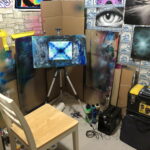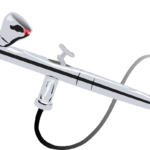While most people are aware of what airbrushes are, very few could explain exactly how an airbrush works. This is because the inner workings of airbrushes involve tiny mechanical components that regulate how the paint is discharged onto the substrate. However, by really understanding how an airbrush works, you can learn to troubleshoot any issues and use your airbrush like a pro.
Checkout this article about the different kinds of airbrushes for a great introduction to airbrush types.
Atomization is the key process that every airbrush uses to operate. Atomization involves breaking down paint, ink, or dye into droplets so that it can be sprayed in various forms. Simply put, atomization describes any process that breaks up bulk liquids into droplets. Even pouring water out of a pitcher is a way to achieve atomization as the water stream starts to break up the higher that you pour and the further that the water falls.
For an in-depth look at the main types of atomization and the fluid properties affecting this process, checkout this atomization training document from Graco Inc.
This article will only be talking about air atomization, the category of atomization that airbrushes achieve.

How an airbrush works using air atomization
In the process of air atomization, a low speed stream of liquid is combined with a highspeed stream of air. This combination creates friction between the air and the liquid which causes atomization.
How a single action airbrush works
The terms “single action” and “double-action” reflect how the airbrush user controls the air and paint flow.
Single action airbrushes work much more like aerosol cans where the user simply pushes a trigger for the airbrush to spray. What this means is the user will have almost no control over how much the airbrush sprays, which means single action airbrushes are simple to use but they are much less flexible than double-action options. Single action airbrushes are best used for painting solid colors, such as in the application of spray-on tans or autobody coats.
The trigger on a single-action airbrush can be thought of as a simple on/off switch or button. The fluid is sprayed at a constant rate because the user cannot pull the needle back variably as is possible with a double action airbrush.
How a double action airbrush works
Double action airbrushes have a more complex system for spraying. Instead of simply pressing a button or trigger, the user has a push and pull system where pressing the trigger releases the air and pulling it back releases the color. This means that color is more gradually released and the user has much more flexibility in his work. If the user pulls the trigger lightly, the airbrush will spray more precise lines, but pulling the trigger back further will cause the spray area to widen.
The increased latitude offered by a double action airbrush makes it superior to single action airbrushes. This is because a double can do anything a single can do and more. Double action airbrushes are usually used for more artistic purposes since you can control the flow of paint and air. The double action airbrush sets a needle which pokes through the opening of the nozzle creating a seal. The needle, which is controlled by the trigger, is then pulled back from the opening of the nozzle. This breaks the seal, and allows a stream of air to move around the needle, past the reservoir of paint, and out the opening of the nozzle – this is the point of atomization. As the needle is pulled back more, the opening at the tip of the nozzle widens, airflow increases, more paint droplets are atomized, and the spray pattern becomes larger.
How an internal mix airbrush works
Internal mix airbrush systems work by mixing the paint and air together inside the tool. The paint comes into the mixing area from the feed system, and as the airstream is engaged, liquid paint enters the highspeed airstream, achieving atomization. Then the atomized paint is discharged from the nozzle creating a fine dot pattern.
Internal mix airbrushes are ideal for smooth shading patterns because of how fine the particles become. Most modern double and single action airbrushes are now internal mix – the single action being used for shading, and the double action being used for shading and fine detail work.
How an external mix airbrush works
External mix airbrushes mix paint and air outside the tool, producing a larger and coarser spray pattern. A high-speed air stream is expelled from an air nozzle and over the paint spout. The airstream produces a low-pressure system and “pulls” the liquid paint out of the spout and into the airstream. Therefore, the point of atomization is outside the tool.
Because of the coarse spray pattern, external mix airbrushes have fallen to the wayside over the years to make way for their internal mix counterparts. But for some jobs, they will work just fine. The main advantages of external airbrushes are that they’re easier to clean, harder to clog, and they can generally handle thicker paints than internal mix options.
How a gravity fed airbrush works
The terms gravity fed and siphon fed describe how the paint is supplied to the airbrush. Gravity and siphon fed options are both prevalent with external and internal mix, as well as both double action and single action airbrushes.
Gravity fed airbrushes have the color cup located on top of the airbrush. Gravity pulls the paint down and delivers it into the mixing area, providing a steady paint supply.
How a siphon fed airbrush works
Siphon fed airbrushes use an air pressure differential system to pull paint into the mixing area from below – kind of like the external mix system, although, siphon fed airbrushes can also be internally mixed. They generally have an attachable bottle system that allows you to switch out solid colors by switching the bottle which provides an ability for switching colors quickly.
When deciding to purchase an airbrush, there are many other aspects to consider besides the way they achieve atomization. Some of these things include choosing the proper feed system, the proper nozzle size, and the way it feels in your hand. Checkout this other article on the different kinds of airbrushes, or, if you want to cut to the chase, checkout this article about the best multipurpose airbrush on the market.
There are many different airbrushes to suit many different needs, but knowing how an airbrush works is key to making the right decision. If you pick a single-action airbrush when you need a double, it will make your job a great deal more difficult.
Buying tools for art is like buying them for any other activity. For example, you would never use a screwdriver for a job when you really need to use a wrench.
Hopefully this article has given you some info to use for picking the right airbrush, troubleshooting your airbrush properly, and taking your airbrush art to the next level.


